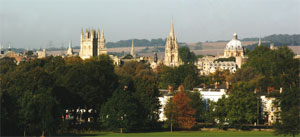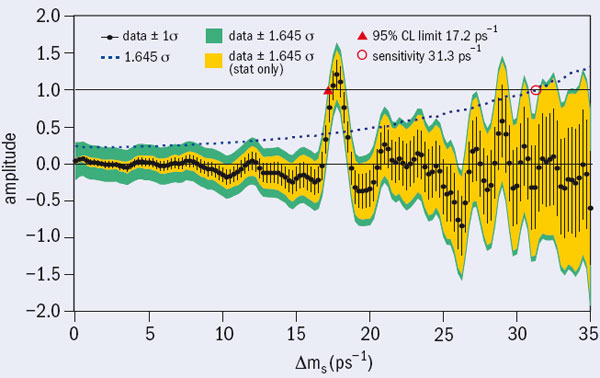Lively discussions and precise measurements dominated Beauty 2006, the latest international conference on B-physics. Neville Harnew and Guy Wilkinson report.
The 11th International Conference on B-Physics at Hadron Machines (Beauty 2006) took place on 25–29 September 2006 at the University of Oxford. This was the latest in a series of meetings dating back to the 1993 conference held at Liblice Castle in the Czech Republic. The aim is to review results in B-physics and CP violation and to explore the physics potential of current and future-generation experiments, especially those at hadron colliders. As the last conference in the series before the start-up of the LHC, Beauty 2006 was a timely opportunity to review the status of the field, and to exchange ideas for future measurements.

More than 80 participants attended the conference, ranging from senior experts in the heavy-flavour field to young students. The sessions were held in the physics department, with lively discussions afterwards. There were fruitful exchanges between the physicists from operating facilities and those from future experiments (LHCb, ATLAS and CMS), with valuable input from theorists.
The conference reviewed measurements of the unitarity triangle, which is the geometrical representation of quark coupling and CP-violation in the Standard Model. The aim is to find a breakdown in the triangle through inconsistencies in the measurements of its sides and its angles, α, β and γ (φ2, φ1 _and φ3), as determined through CP-violating asymmetries and related phenomena.
The statistics and the quality of the data from the first-generation asymmetric energy e+ e– B-factories are immensely impressive. The BaBar and Belle experiments, at PEPII and KEKB respectively, passed a significant milestone when they reached a combined integrated luminosity of 1000 fb-1 (1 ab-1), with 109 b bbar pairs now produced at the Υ(4S). The experiments are approved to continue until 2008 and should double their data-sets.

The B-factories have studied with high precision the so-called golden mode of B-physics, the decay B0→J/ΨKs. The CP-asymmetry in this decay accesses sin 2β with negligible theoretical uncertainty and the measured world-average value in this and related channels is now 0.675 ± 0.026. The four-fold ambiguity in the value of β can be reduced to two by measuring cos 2β in channels such as B0→D*D*Ks. The results now strongly disfavour two of the solutions, although higher statistics and further theoretical effort are necessary to verify this interpretation.
A possible hint of physics beyond the Standard Model may appear in the measurement of sin 2β in b→s “penguin” decays (e.g. B0→φKs). There is a 2.6σ _discrepancy in the value averaged over a number of channels, namely sin 2β = 0.52 ± 0.05, when compared with the charmonium measurement. We need more data to resolve this ambiguity, and eagerly await further studies of these penguin processes at the LHC.

BaBar and Belle have also produced important results related to the angles α and γ. The γ measurements are particularly interesting as it had generally been assumed that this parameter was beyond the scope of the B-factories. The angle is measured through the interference of tree-level B±→ D(*) K± and B± →Dbar(*)K± decay amplitudes. This strategy is intrinsically clean, and leads to a combined result for γ of 60(+38-24)°. The errors are still large and a precise measurement of γ is impossible at the B-factories. However, the LHCb experiment at CERN will improve the error on γ to less than 5°, with measurements contributing from the Bu, Bd and Bs sectors.
Year of the Tevatron
Despite the great successes of the B-factories, Beauty 2006 focused on B-physics at hadron machines, and 2006 has been the “Year of the Tevatron”. The CDF and D0 experiments at Fermilab’s Tevatron have not only demonstrated the proof-of-principle of B-physics at hadron machines, but have also made measurements that are highly competitive and complementary to those of the B-factories, in particular through the unique access that hadron machines have to the Bs sector. The results indicate the future at the LHC, where there should be 100 times more statistics.
The highlight of the conference was the first 5 σ observation of Bs oscillations, presented by the. They reported the mass difference between the mass eigenstates, Δms, as 17.77 ± 0.10 (stat) ± 0.07 (syst) ps-1, in agreement with Standard Model expectations. Data from hadronic channels, such as B0s→Dsπ have greatly enhanced the statistical power of the analysis; this measurement relies on the precision vertex detector. The measurement of Δms and Δmd allows the ratio of Cabibbo–Kobayashi–Maskawa (CKM) matrix elements |Vtd|/|Vts| to be extracted with around 5% systematic uncertainty (with input from lattice theory), which fixes the third side of the unitarity triangle with the same precision.
The study of rare processes dominated by loop effects provides an important window on new physics and should have significant contributions from new heavy-particle exchanges. The Tevatron experiments are intensively searching for the very rare decay Bs→μμ, which is expected to have a branching ratio of order 10-9 in the Standard Model, but is significantly enhanced in many supersymmetric extensions. The Tevatron is currently sensitive at the 10-7 level and is striving to improve this reach. The LHC experiments will explore down to the Standard Model value.
Towards the LHC
With the start-up of the LHC, B-physics will enter a new phase. Preparations for the experiments are now well advanced, as are the B-triggers necessary to enrich the sample in signal decays. Talks at the conference described the status of the detectors and their first running scenarios. The LHC pilot run scheduled for late 2007 will yield minimal physics-quality data, but will be invaluable for commissioning, calibrating and aligning the detectors. Researchers will accumulate the first real statistics for physics measurements in summer 2008. Key goals in the first two years of operation will be the first measurement of CP violation in the Bs system; a measurement approaching the Standard Model value (around 2°) of the Bs mixing phase in Bs→J/Ψφ; the likely first observation of the decay Bs→μμ; studies of the B angular distributions sensitive to new physics in the channels Bu,d→K*μμ and precise measurements of the angles α and γ. LHCb will cover a wide span of measurements, whereas ATLAS and CMS will focus on channels that can be selected with a (di-)muon trigger.
Participants at the conference made a strong science case for continued B-physics measurements beyond the baseline LHC programme, to elucidate the flavour structure of any new physics discovered. On the timescale of 2013, the LHCb collaboration is considering the possibility of upgrading the experiment to increase the operational luminosity to 10 times the present design, to accumulate around 100 fb-1 over five years. In addition there are two proposals on a similar timescale for asymmetric e+e– “Super Flavour Factories” at luminosities of around 1036 cm-2s-1 – SuperKEKB and a linear-collider-based design (ILC-SFF) – each giving some 50 ab-1 of data by around 2018. The LHCb upgrade and the e+e– flavour factories largely complement each other in their physics goals.
Social activities enabled discussions outside of the conference room. Keble College provided accommodation and hosted the banquet at which Peter Schlein, the founder of the conference series and chair for the first 10 meetings, was thanked for his efforts over the years and his pioneering contributions to B-physics at hadron machines.
The conference was extremely lively: B-physics continues to flourish and has an exciting future ahead. The B-factories and the Tevatron have led the way, but there is still much to learn. Heavy flavour results from ATLAS, CMS and, in particular, LHCb seem certain to be a highlight of the LHC era.








